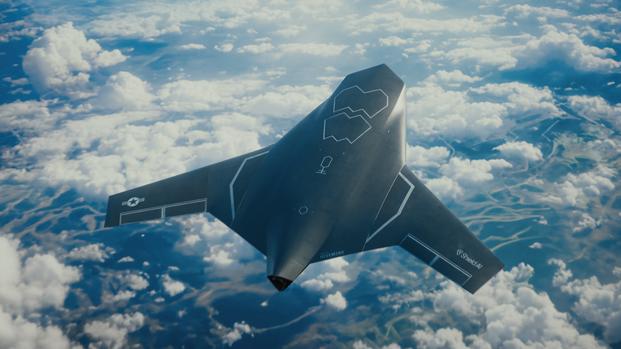A San Diego defense technology company unveiled an artificial intelligence-piloted fighter jet Tuesday that can take off vertically without runways, accelerating the Pentagon's push toward a future where autonomous drones fly combat missions alongside human pilots.
Shield AI revealed the X-BAT during an event in Washington, marking the company's entry into the emerging market for military drones. The jet-powered aircraft, controlled by Shield AI's Hivemind software, promises to operate in combat environments where GPS and communications are unavailable or unreliable.
An AI Jet Built for Combat
The X-BAT stands apart from other autonomous aircraft concepts through its vertical takeoff and landing capability combined with extended range and combat power.
According to the company, Shield AI designed the aircraft around a proven fighter-class engine. The X-BAT combines VTOL capability with a range exceeding 2,000 nautical miles with full mission payload and can reach altitudes above 50,000 feet.
“X-BAT is a revolution in airpower because it combines four things – VTOL, range, multirole capability, and autonomy,” said Armor Harris, senior vice president of aircraft at Shield AI. “VTOL plus range solves survivability on the ground and dependency on tankers. Multirole provides critical flexibility as the threat evolves, because no plan survives first contact with the enemy.”

Shield AI said the aircraft can carry weapons internally and externally, performing strike, counter air, electronic warfare, and intelligence missions. Up to three X-BATs can fit in the deck space of one legacy fighter or helicopter.
Brandon Tseng, Shield AI's co-founder, president and former Navy SEAL, emphasized the strategic advantage of runway-independent operations. “Airpower without runways is the holy grail of deterrence,” he said. “It gives our forces persistence, reach, and survivability, and it buys diplomacy another day.”
The company said X-BAT is priced in the same range as other Collaborative Combat Aircraft programs, with the exact cost varying based on mission systems and configurations. Shield AI told Military.com the aircraft delivers roughly a tenfold improvement in cost per effect compared to fifth-generation aircraft, with additional savings from eliminating pilot training costs and reducing risk to pilots.
Customer engagements are progressing well, the company said, though it declined to identify which military services or programs have expressed interest beyond the Air Force's CCA initiative.
Shield AI has completed ground tests validating the airframe, engine, and vertical takeoff capability, with first flights expected in fall 2026 and full mission capability demonstrations by 2028.
What This Means for the Military
The X-BAT unveiling reflects the Air Force's accelerating push into autonomous warfare through its Collaborative Combat Aircraft program, which aims to field AI-enabled drones as force multipliers for crewed fighters.
The service set a planning assumption of 1,000 CCAs, according to the Congressional Research Service, suggesting two autonomous aircraft for every advanced fighter.
Former Air Force Secretary Frank Kendall demonstrated the military's commitment to AI pilots in May 2024 when he flew aboard an autonomous F-16 at Edwards Air Force Base. The X-62A VISTA, piloted by AI during dogfighting maneuvers, reached speeds exceeding 550 mph. After the flight, Kendall said he would trust the AI with weapons launch decisions.

Shield AI provides mission autonomy software for the Air Force's CCA program alongside RTX. General Atomics and Anduril are building airframes for the program's first increment, with production decisions expected in fiscal year 2026.
But the Pentagon's growing reliance on venture-backed defense companies for critical weapons systems raises questions about production capacity and long-term sustainability. Shield AI, valued at $5.3 billion, has raised $1.3 billion from investors including Andreessen Horowitz and L3Harris Technologies.
The company must prove it can deliver aircraft that meet military requirements — a challenge that has stumped defense companies before. Forbes and CNBC reported an April 2024 incident where a U.S. Navy service member had three fingers partially severed during a V-BAT drone landing demonstration. The company has since passed two Pentagon safety audits and redesigned the V-BAT to eliminate the need for human assistance during landing.
Nevertheless, the X-BAT shows how rapidly autonomous combat aircraft are moving toward operational deployment, driven by private companies entering the field of military aviation.
















